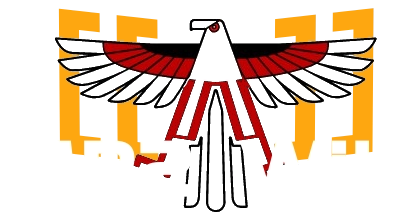Changes By Year
In addition to a new body shape, moving away from the short based MKI, the MKII (known by it’s SW20 engine model) was 200mm longer in length, 80mm longer in wheelbase and about 150kg heavier. Apparently, MKII MR2’s were hand built – Toyota subcontracted to Yamaha, at a build rate of about 2000 per month.
Most Turbo models have fog lights (a few early models didn’t have them). NA models never came with fog lights.
1989-1991 (1st generation)
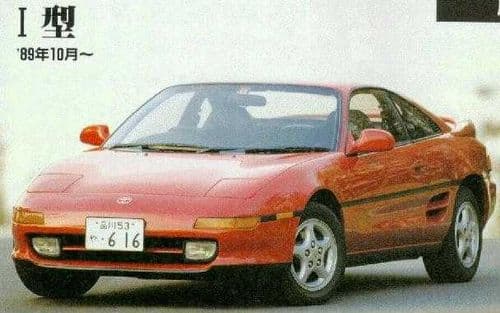
Produced in Japan during 10/1989 - 12/1991. Available in the USA during 1991-1992. These model year cars were essentially identical. 1992 model year cars were not produced for a full year; instead, the improved 1993 version took over production lines in mid 1992.
- 14" wheels were standard, 195/60 front and 205/60 rear tires.
- The rear spoiler was optional on the N/A MR2, but dealers tended to equip them with one.
- Black or blue cloth or black leather
11,211 (1991) and 6,188 (1992) sold in the US.
Options
- anti-lock brakes (ABS)
- electro-hydraulic power steering (EHPS)
- air conditioning
- power locks
- power mirrors
- power windows
- leather seats and trim
- premium stereo
- dimming interior lights
- alarm
- cruise control
Colours
Available only in 1991/92:
- Aquamarine Pearl (742)
New colors introduced:
- Nautical Blue (8H3)
- Black (202)
- Super White I (043)
- Crimson Red (3J6)
- Signal Yellow (567)
- Steel Mist Gray (187)
1991-1993 (second generation)
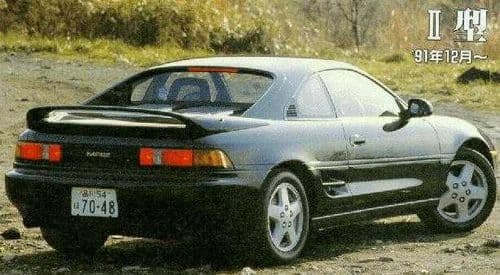
Produced from 12/1991 - 10/1993. Available in the USA during 1992-1993.
Introduced with 135hp, 4 cylinder, 16 valve, normally aspirated engine and optional 240-260 hp, 4 cylinder, 16 valve turbocharged engine in GT-S and GT form.
- Larger front lip spoiler changed to a more angular design.
- Non-turbo models received 5-hp improvement to 135hp.
- Revised, stiffer rear suspension geometry included 1" lower stance.
- Upgraded front and rear springs.
- Larger 15" “square spoke” 5-star wheels with 195/55 front and 225/50 rear tires.
- Longer lug nuts front and rear.
- Different torsion bar and pivot points for reduced toe change under heavy cornering loads.
- Improved transmission in Turbo cars, with changes to the 2nd and 3rd gear syncros.
- Larger brake rotors.
- Shorter throw manual shifter added.
- A limited slip differential (LSD) was an available option on the Turbo model.
- A second subwoofer was added behind the passengers seat.
- Larger throttle body on the Turbo, although not any wider diameter. Revised throttle linkage engagement.
2,917 sold in the US, including approximately 10 hardtop Turbos.
Last year of production for Canada.
Options
keyless entry
limited slip differential
premium stereo option included 8-speakers versus the previous 7-speaker setup
black and ivory leather
Colours
Available only in 1993:
- Blue (8J2)
- Turquoise Pearl (746)
New colors introduced:
- Super Red (3E5)
- Super White (040)
Recalls
1991
- Steering wheel crash test failure, VIN # SW22M, SW22N-0000001 to 0059265 and SW21M, SW21N-0000001 to 0017719
- Air conditioning expansion valve could malfunction, reducing efficiency VIN # SW22M, SW22N-0000001 to 0076191 and SW21M, SW21N-0000001 to 0019446
1993-1995 (third generation)

Produced during 10-1993 - ?/1995. There were no Turbo models without T-Tops this year.
- Emphasis on safety and more user friendly for inexperienced drivers. This was a result of complaints regarding snap oversteer which is a common charachteristic of supercars at the time.
- Updated one-piece rear spoiler.
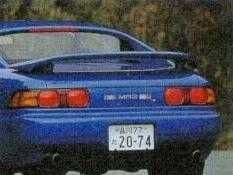
- Color-matched body trim, including color-keyed front air-dam.
- Chassis modifications.
- Redesigned round taillights, and a redesigned cluster, with the back center honeycomb removed, and the reverse lights moved in closer to the center.
- New engines for NA producing 185 hp and Turbo changed from ceramic version to slightly smaller one producing 245 hp.
- No sunroof or hardtop body available for Turbo models: all turbos came with t-top.
- Dual airbags (passenger side airbag introduced).
- Lower body cladding, front lip spoiler and side black strip molding all painted to match body.
- Air-conditioning changed to meet environmental regulations.
- Bilstein shocks, with improved shock rates, and multistage struts.
- Slightly smaller steering wheel (10 mm smaller at 370 mm versus 380 mm), with no center “MR2” logo.
- Indicator (blinker) lights added to the front quarter panels.
908 sold in the US.
The JDM MR2 Turbo initially produced 220hp and 245hp at 14.5psi from 1994 on. Japanese model available with traction control and in dash 4" TV.
Colors
New colors introduced:
- Solar Yellow (576) Dark Green Pearl (6M1)
- Tropical Blue (8B6)
1996-1998 (4th generation)
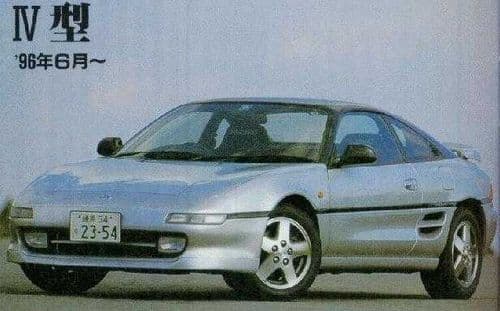
Released in June 1996. (Also see 1993 v 1998 changes.) In the US the 1994-95 are the rarest and most expensive versions of the MR2. Most MR2 Turbo were equiped with the T-top roof, fewer with a removable glass sunroof. The hardtop is rare in the US, and is highly sought by racers because of their lighter weight and stiffer chassis.
The MR2 continued to be available in Europe and Japan until 1998 model year. Suspension revisions continued into the final year. Wheel design was changed every few years.
JDM non-turbo cars always utilized the 3S-GE engine instead of the 5S-FE. This engine is the same as the Turbo version, except with higher compression pistons, no turbocharger, different intake manifold, as well as other changes. Initially these engines produced 165hp, later 200hp.
The MR2 was also available in a limited edition convertible, known as the MR2 Spyder, in 1996. This should not be confused with the new MR2 Spyder available in the US.
- Clear corners added; front side reflector replaced by trim and moved near the driver’s door above the trim.
- Returned to the separate colored trim abandoned in the previous generation.
- 10th anniversary limited edition launched in Britain.
- No turbo models available in California-emissions regulation states.
- Revised intercooler.
- Upgraded CD player.
- Black roof paint scheme.
~356 sold in the US. Last year available in the US.
Colors
Available in 1995 only:
- Silver (199, 10 year anniversary edition)
